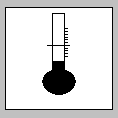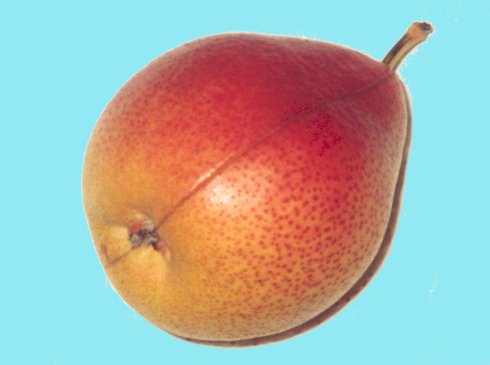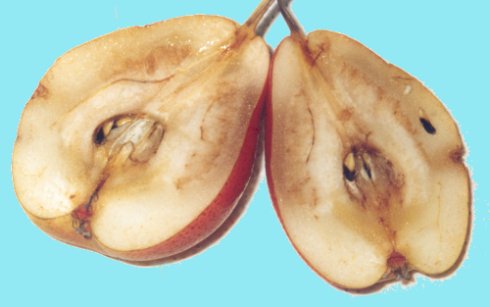| Pears | [German version] |
Table of contents |
|
| General: | ||
| Product information | ||
| Packaging | ||
| Transport | ||
| Container transport | ||
| Cargo securing | ||
Product information
Product name
| German | Birnen |
| English | Pears |
| French | Poires |
| Spanish | Peras |
| Scientific | Pyrus communis |
| CN/HS number * | 0808 20 ff. |
(* EU Combined Nomenclature/Harmonized System)
Product description
Pears belong to the rose family (Rosaceae) and are thought to originate from parts of Asia and Europe.
Pears are a pomaceous fruit, like apples and quinces. Pomaceous fruits are false fruits with whitish, firm pulp and a generally sour-sweet flavor. The small brown seeds (pips) are located in a parchment-like core with five compartments.
Depending on time of harvest, pears are subdivided into early varieties (which reach eating ripeness on the tree) and late varieties (which reach eating ripeness only postharvest). Pears vary in color from green through yellow-green to yellow. Some varieties are even red in parts. The low fruit acid content in many varieties of pear makes them very sweet. Imports from the southern hemisphere ensure a plentiful supply all year round.
Pears picked when green have a turnipy taste and tend to shrivel prematurely. Preclimacteric pears do not ripen easily and remain green and hard, and have a particularly large number of stone cells grouped around the core.
To determine the degree of ripeness of pomaceous fruit, the hardness of the pulp is measured using a pressure tester, which involves pressing a cylindrical steel pin into the pulp. The maximum pressure is read off in pounds. Pears exhibit a degree of hardness of 9 – 10 pounds, which decreases by 3 – 4 pounds during ripening. By comparison, the reading for most varieties of apple lies between 18 and 20 pounds, their hardness decreasing by 5 – 6 pounds during ripening. Pears are therefore more sensitive than apples.
Examples of well-known varieties are:
| „Williams Christ“ | |
| „Conference“ | |
| „Abate Fetel“ | |
| „Gute Luise“ |
Quality / Duration of storage
Pears, which ripen quickly, may lose 3 – 4 pounds before they become overripe. However, if kept in cold stores at 0°C, they may still exhibit hardness values of 9 – 10 pounds even after several months.
A characteristic feature of pears is their rapid transition from the ripe to the overripe stage. Thus, whenever a cargo of pears is unloaded in the ripe state, large losses are sure to ensue, since within a few days they will be overripe and will lose market value. For this reason, great care must be taken when inspecting cargo that no pears are loaded whose degree of hardness differs substantially from that indicated above. A difference of around 1 pound is tolerated.
The pears must be firm, clean, free of mold and foreign odors or flavors, have a good color and contain as few stone cells as possible.
Maximum storage duration is highly dependent upon the particular variety of pear. In general, it can be said that pears have a storage life of approx. 1 – 5 months. The temperature should be approx. -1 – +1°C and the relative humidity approx. 90 – 95%.
Where controlled atmosphere transport is used, transport and storage duration may be extended. The following parameters apply in such a case [16]:
| Temperature | Rel. humidity | O2 | CO2 | Suitability for controlled atmosphere |
|---|---|---|---|---|
| 0.6 – 1.7°C | 90 – 95% | 2 – 3% | 0 – 1% | very good |
Intended use
Pears are mainly eaten fresh, but they may also be canned and used to produce juices and fruit-based spirits etc.
Figures
(Click on the individual Figures to enlarge them.)
 Figure 1 |
 Figure 2 |
 Figure 3 |
 Figure 4 |
Countries of origin
This Table shows only a selection of the most important countries of origin and should not be thought of as exhaustive.
| Europe | Netherlands, Italy, Spain, France, Germany, Austria, Belgium |
| Africa | South Africa |
| Asia | China |
| America | Argentina, USA, Brazil |
| Australia | Australia, New Zealand |
Back to beginning
Packaging
Pears are wrapped individually in tissue paper to reduce susceptibility to pressure and impact. They are transported in crates, tubs and cartons. The packaging must allow air circulation for refrigeration purposes.
Pears from Brazil are wrapped in sulfate paper to protect them from light.
Back to beginning
Transport
Symbols
 General cargo |
 Temperature-controlled |
Means of transport
Ship, aircraft, truck, railroad
Container transport
Refrigerated container with fresh air supply or controlled atmosphere
Cargo handling
Because of its impact- and pressure-sensitivity, the fruit has to be handled with appropriate care.
The required refrigeration temperature must always be maintained, even during cargo handling.
In damp weather (rain, snow), the cargo must be protected from moisture, as there is otherwise a risk of premature spoilage.
Stowage factor
| 2.52 m3/t (cartons) [1] | |
| 2.45 m3/t (jointed wooden boxes) [1] | |
| 2.26 – 2.29 m3/t (boxes) [11] | |
| 2.05 – 2.96 m3/t (cartons) [11] |
Stowage space requirements
Cool, dry, good ventilation
Segregation
Marker pen, oil crayon, fiber rope, thin fiber nets
Cargo securing
Because of its considerable impact- and pressure-sensitivity, packages of this cargo must be secured in such a way that they are prevented from damaging each other. Spaces between packages or pallets must be filled, to prevent slippage or tipping. By selecting the correct packaging size or cargo unit (area module or area module multiple), holds can be tightly loaded (without spaces).
Back to beginning
Risk factors and loss prevention
RF Temperature
Pears require particular temperature, humidity/moisture and ventilation conditions (SC VII) (storage climate conditions).
A written cooling order must be obtained from the consignor before loading is begun. This order must always be complied with during the entire transport chain.
The following Tables merely constitute an estimate of appropriate temperature ranges. Temperatures may deviate from these values, depending on the particular transport conditions.
| Designation | Temperature range | Source |
|---|---|---|
| Travel temperature | 0 – 0.5°C | [1] |
| -1 – +1°C | [2] | |
| -1 – 0°C | [5] | |
| -1°C | [9] | |
| 0.5°C | [11] | |
| 1 – 2°C | [39] |
Cooling of pears must proceed as rapidly as possible, to prevent degradation of quality. In pears, the heat of ripening is twice that of apples and approximately four times that of oranges. It is therefore extremely important to bring the cargo as quickly as possible to the necessary travel temperature. This may be achieved by precooling of the cargo and the holds/containers, for example. Where a cargo is not precooled, a large-capacity refrigeration plant is required, as the accumulated heat is very considerable.
Pears are less prone to internal breakdown than apples.
 Figure 6 |
 Figure 7 |
Chilling damage in pears occurs as high as -2°C [2]. Freezing injury is present in pears if the water-soaked part of the flesh of the fruit lies just beneath the skin while the rest of the pulp is particularly dry.
Back to beginning
RF Humidity/Moisture
Pears require particular temperature, humidity/moisture and ventilation conditions (SC VII) (storage climate conditions).
| Designation | Humidity/water content | Source |
| Relative humidity | 90% | [1] |
| 80 – 90% | [2] | |
| 80 – 90% | [9] | |
| 90 – 95% | [39] | |
| Water content | 81 – 83% | [1] |
| Maximum equilibrium moisture content | 90% | [1] |
Relative humidity should be kept to the value stated, in order to prevent the fruit from losing moisture. Wrapping the fruit in polyethylene film considerably reduces the risk of moisture loss.
Back to beginning
RF Ventilation
Pears require particular temperature, humidity/moisture and ventilation conditions (SC VII) (storage climate conditions).
Recommended ventilation conditions: circulating air, 40 – 60 circulations/hour with continuous supply of fresh air
The circulation fans must be set to full power, due to the fruits‘ high level of metabolic activity and the associated production of respiratory gases. After the reduction period, the fresh air supply should be metered on the basis of the measured CO2 content of the hold air.
Back to beginning
RF Biotic activity
Pears display 2nd order biotic activity.
They are living organs in which respiration processes predominate, because their supply of new nutrients has been cut off by separation from the parent plant.
Care of the cargo during the voyage must be aimed at controlling respiration processes (release of CO2, water vapor, ethylene and heat) in such a way that the cargo is at the desired stage of ripeness on reaching its destination. Inadequate ventilation may result in fermentation and rotting of the cargo as a result of increased CO2 levels and inadequate supply of atmospheric oxygen (see Ventilation).
Back to beginning
RF Gases
| CO2 evolution | at 0°C: 4.8 mg/kg*h [1] |
| Upper limit of permissible CO2 content | 1.0 vol.% [1] < 1.0 vol.% [39] |
| Ethylene evolution | |
| Active behavior | Climacteric pears exhibit high levels of ethylene production. The ethylene production rate is 10 – 100 µl/kg*h [16]. |
| Passive behavior | The sensitivity of pears to ethylene may be classified as high [16]. They must not therefore be stored together with ethylene-producing goods (allelopathy). |
In fresh fruit, metabolic processes continue even after harvesting. The fruit absorbs oxygen (O2) and excretes varying amounts of carbon dioxide (CO2) and ethylene (C2H4) as well as aromatic compounds during the conversion of starch into sugar (ripening process).
If ventilation has been inadequate (frost) or has failed owing to a defect, life-threatening CO2 concentrations or O2 shortages may arise. Therefore, before anybody enters the hold, it must be ventilated and a gas measurement carried out. The TLV for CO2 concentration is 0.49 vol.%.
Pears give off twice as much heat of respiration as citrus fruits. Where a cargo has not been precooled, heat continues to accumulate, possibly leading to the evolution of life-threatening CO2 concentrations (up to 10 vol.%) during the reduction period. After the reduction period, the CO2 content should never be > 1 vol.%.
Back to beginning
RF Self-heating / Spontaneous combustion
No risk.
Back to beginning
RF Odor
| Active behavior | Pears have a slight, pleasant odor |
| Passive behavior | Pears are very odor-sensitive and should not be stowed together with goods such as meat, butter and cheese. |
Back to beginning
RF Contamination
| Active behavior | Pears do not cause contamination |
| Passive behavior | Pears are sensitive to dust, dirt, fats and oils. Clean packaging is absolutely essential, since the cargo may spoil very rapidly as a result of mold or bacterial attack. The holds or containers must accordingly be clean and in a thoroughly hygienic condition before loading. |
Back to beginning
RF Mechanical influences
Pears are highly sensitive to impact and are therefore generally additionally wrapped (e.g. in wood wool or tissue paper). The fruit must be handled very carefully, since, in the event of strong pressure or jolting/vibration, the fruit rapidly succumbs to bruising and may start to rot within just a few days.
Where possible, the pears should be of uniform size to even out pressure and prevent injury. Size grading is generally performed mechanically. If grading is performed by hand, gaging rings or gaging boards are used. Dessert pears are divided into three quality classes: extra, I and II.
Back to beginning
RF Toxicity / Hazards to health
If ventilation has been inadequate (frost) or has failed owing to a defect, life-threatening CO2 concentrations or O2 shortages may arise. Therefore, before anybody enters the hold, it must be ventilated and a gas measurement carried out. The TLV for CO2 concentration is 0.49 vol.%.
Back to beginning
RF Shrinkage/Shortage
The normal weight loss due to a reduction in the moisture content of the product is < 1% [1].
Added to this are losses of volume caused by packaging breakage, which should not however be greater than 0.4% [2].
Back to beginning
RF Insect infestation / Diseases
Soft rot or blue mold rot: caused by the mold Penicillium expansum. Rot spots are light brown, moist, slightly sunken and of varying size. The rot spreads very quickly throughout the entire fruit, without changing its shape. It is accompanied by an unpleasant odor.
Gray mold rot: pathogen – the mold Botrytis cinerea. An infected fruit is covered with a dense, spider’s web-type, ash-gray, very dusty mold. The rotting pulp has a slightly sour odor and is darker and firmer than in pears suffering from blue mold rot. This fungus is one of the most feared diseases of storage.
Freezing injury: the fruit takes on a glassy, water-soaked appearance. Cutting the fruit in half reveals that the water-soaked part of the flesh of the fruit is located just beneath the skin. The rest of the pulp is unusually dry and sometimes cracked. Freezing injury may set in over 4 – 6 weeks at a temperature anywhere below freezing point (-2°C).
Overripeness: a characteristic feature of pears is their rapid transition from the ripe to the overripe stage. Thus, whenever a cargo of pears is unloaded in the ripe state, large losses are sure to ensue, since within a few days they will be overripe and will lose market value. For this reason, great care must be taken when inspecting cargo that no pears are loaded whose degree of hardness differs substantially from that indicated above. A difference of around 1 pound is tolerated.
 Figure 5 |
The quarantine regulations of the country of destination must be complied with and a phytosanitary certificate may have to be enclosed with the shipping documents. Information may be obtained from the phytosanitary authorities of the countries concerned.
Back to beginning
